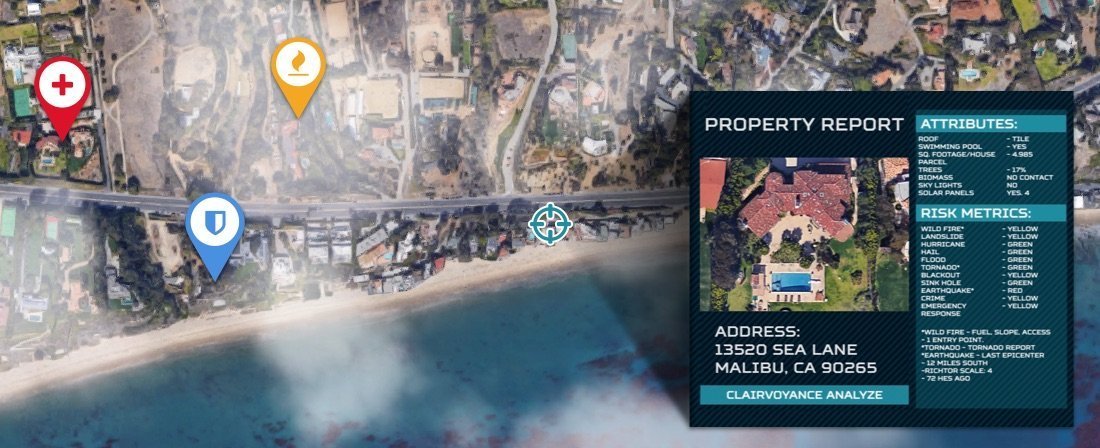According to Accenture, approximately 66% of A&D executives polled indicated they are looking at investing in AI for 2019, particularly on security, production, and R&D. 80% believe that AI-based decisions will have a direct impact on the workforce by 2021.
It seems that most of the AI startup companies catering to the aerospace industry do so as a segue from the energy and heavy industry sectors or as a commission from military entities. The most developed AI software for the space appears to deal with preventive maintenance and operational efficiency, and the least developed seem to be machine vision and threat detection software.
While AI-equipped autonomous vehicles may soon provide software developers with more data, autonomous vehicle technology is still a long way from self-piloting aircraft carrying human passengers. We believe it is unlikely that there will be full-blown adoption of AI-based software in the aerospace industry by 2021.
That said, there are several companies claiming to offer AI solutions to aerospace companies. We found that these solutions are intended to help aerospace companies with at least one of the following:
- Preventive maintenance and operational efficiency
- Threat detection
What Business and Government Leaders in Aerospace Should Know
Uptake employs many data scientists with PhDs and Master’s degrees in computer science and various hard sciences. The company’s Director of Data Science and Analytics holds a PhD in Nuclear Engineering and Engineering Physics. He spent 12 years as a nuclear engineer at Argonne Lab, 10 years at Smart Signal, 4 of which as Chief Technologist and Vice President; and 3 years as Chief Scientist, Industrial Data Intelligence at GE Intelligent Platforms. In other words, there’s a very high likelihood that Uptake is offering genuine machine learning.
In particular, the company offers machine learning software for asset management and maintenance. Uptake primarily focuses on the energy and heavy equipment industries, but it has lately been tapped by Rolls Royce to optimize its Trent aircraft engine fleet. In addition, they worked with Berkshire Hathaway Energy to create a predictive maintenance software for their turbines.
Sparkcognition offers a predictive maintenance software to aerospace companies, similar to Uptake. It lists Mitsubishi as a past client, and it’s currently forming a division with Boeing. The company’s CTO worked at IBM for 17 years, where he was CTO of IBM Watson Platform and Partnerships. He also spent a year at Citi, where he was Executive Architect. Once again, the company employs many data scientists with robust academic experience in the hard sciences, mathematics, and computer science.
Neurala’s CEO and CTO both hold PhDs in Cognitive and Neural Systems. Companies with C-level executives hold advanced degrees in fields that translate well to artificial intelligence are often the most capable of procuring AI talent and offering machine learning software. It bodes well for companies looking to leverage AI when the people in charge are either already familiar with it or have the capability to get up to speed relatively quickly. We discuss this and two other rules of thumb for vetting AI companies on their claims to AI in our article on cutting through the AI hype. Neurala offers machine vision software for autonomous navigation.
Orbital Sidekick seems to be developing an AI model that looks at spectral data to detect anomalies in images. In addition, the company sent a payload to space via the SpaceX CRS-15 Mission to the International Space Station to collect data. Orbital Sidekick. Although the company does pay for the services of a data science consultant, members of their 8-person team do not seem to have academic experience with data science and/or artificial intelligence.
Similarly, Slingshot Aerospace seems to be developing machine learning for managing risks and threats in the aerospace industry, although it seems as though their team lacks data science and AI talent on their 20-person team. Both Slingshot and Orbital Sidekick have raised less than $5 million in venture capital, but they were both founded in 2016. It seems they are in their nascent stages. They may require more data science talent before they can build machine learning software for sale.
Uptake
Preventive Maintenance and Operational Efficiency
Uptake offers Asset Performance Management, or APM, which it claims can help the aerospace and defense industry maintain their assets and improve operational efficiencies using predictive analytics.
Uptake claims aerospace companies and government agencies can integrate the software into existing sensor data systems.
We can infer that the maintenance experts at the client company would need to determine where to install sensors on the turbines. These sensors would then collect telemetric data from those parts of the turbine, such as the temperature, pressure, and rotation speed. This data would then be used as a baseline for a properly functioning turbine.
The machine learning model behind the software would need to be trained on millions of these telemetric data points and data about when certain parts of the turbine required maintenance, how long it took, and possibly how long replacement parts took to arrive onsite. The data would then be run through the software’s machine learning algorithm. This would train the algorithm to discern which of all these data points correlate to properly functioning turbine parts, the time at which the turbine has needed maintenance in the past, and which of its parts needed repair.
The software would then be able to predict when certain parts of their turbine are due for maintenance before they break down and to discern which data points correlate to asset health, such as availability, utilization, fuel efficiency, and engine hours per day.
Uptake claims their software was trained on data culled from more than 100 customers and in excess of 1.1 billion hours of operating data, enabling them to produce a trained data science model in less than 2 minutes.
Below is a short 3-minute video demonstrating how Uptake’s APM software helps its clients prevent and predict maintenance issues using the case study of Berkshire Hathaway Energy.
Uptake claims to have helped Berkshire Hathaway Energy or BHE (formerly MidAmerican Energy Holdings Company) save money by predicting turbine breakdowns and increasing efficiencies using sensor data. BHE integrated Uptake’s software into its Intrepid Wind Farm systems. According to the case study, the software immediately identified several issues upon initialization and indicated that something was off with one of the main bearings. BHE’s Maintenance Manager Mark Jeratowski claims they were able to save $250,000 from that one insight 48 hours after implementing Uptake’s software. Uptake also lists Caterpillar and the US Army as some of their past clients.
Jim Herzog is the Director of Data Science and Analytics at Uptake. He holds a PhD in Nuclear Engineering and Engineering Physics from the University of Wisconsin-Madison. Previously, Herzog served as the Industrial Intelligence Chief Scientist at GE Intelligent Platforms
SparkCognition
SparkCognition offers SparkPredict which it claims can help any size enterprise avoid unplanned downtime and breakdowns using predictive analytics.
SparkCognition claims that the software is scalable to any size aerospace and defense enterprise with physical assets and can integrate the software into existing data-collection sensor systems.
We can infer that the aerospace and defense data experts at the client company would need to determine where to install sensors on the physical asset such as an aerial vehicle, ground-based installations, or satellites. These sensors would then collect telemetric data from those parts of the asset, such as fuel use, speed, temperature, and pressure. This data would then be used as a baseline for a properly functioning asset.
The machine learning model behind the software would need to be trained on millions of these telemetric data points and data about when certain parts of the asset required maintenance, how long maintenance on those parts took, and possibly how long replacement parts took to arrive on site. The data would then be run through the software’s machine learning algorithm. This would train the algorithm to discern which of all these data points correlate to properly functioning asset parts, the time at which the asset has needed maintenance in the past, and which of its parts needed repair.
The software would then be able to predict when certain parts of their assets are due for maintenance before they break down.
Below is a short 1.5-minute video demonstrating how SparkPredict works.
SparkCognition claims to have helped an unnamed hydro utility client predict uncommon failures and prevent future unplanned outages, a previous one having cost the client $1.5 million. The problem was there was very little data about the cause of these uncommon and expensive failures, so the client’s existing statistics-based system failed to predict them.
The hydro utility integrated SparkCognition’s software into existing systems with two years worth of sensor data from one turbine to see if it would be able to perform better. According to the case study, the hydro utility received one-month advance warning of potential issues with the turbine six weeks after integrating SparkPredict into the system. SparkCognition claims the hydro utility company is currently considering integrating SparkPredict in four other turbines.
SparkCognition also lists Apergy and Mitsubishi Hitachi Power Systems as some of their past clients.
Sridhar Sudarsan is CTO at SparkCognition. He holds a BS in Computer Science and Technology from National Institute of Technology, Tiruchirappalli. Previously, Sudarsan served as CTO at IBM Watson Platform and Partnerships.
Threat detection
Slingshot Aerospace
Slingshot Aerospace offers the Slingshot Data Platform, which it claims can help aerospace companies identify, categorize, and manage risks and threats using machine vision, geospatial signal processing, analysis, and machine learning.
Slingshot Aerospace claims civil, commercial, and military clients can integrate the software into existing data processing systems.
Slingshot Aerospace claims the machine learning model behind the software was trained on image and video data derived from aerial vehicles, satellites, and other sources from various angles and in various lighting conditions. These images and footage would have been labeled as normal or anomalous. These labeled images and footage would then be run through the software’s machine learning algorithm. This would have trained the algorithm to discern the sequences and patterns of 1’s and 0’s that, to the human eye, form the image or video of a threat or anomaly as displayed in different formats, depending on the needs of the client.
The company claims that after training the model, the client can use the software to achieve space situational awareness, optimized processing algorithms, accelerated decision making, reduced risks, and actionable data.
Slingshot Aerospace claims that the software is still under development. No demo videos, case studies, or client list are currently available. Below is an illustration of what the Slingshot Data Platform would look like.

Luke Wendling is Head of Software Engineering at Slingshot Aerospace. He holds a Master’s in Information Systems from Texas A&M University. Previously, Wendling served as Senior Software Engineer for Advanced Programs at Sotera Defense Solutions, Inc., which has since been acquired by KeyW Corporation.
Neurala
Neurala offers Brains for Bots software development kit (SDK), which it claims can help A&D companies use devices that navigate, recognize objects, and avoid obstructions autonomously using machine vision and deep neural networks.
Neurala claims users can integrate the SDK into any product out-of-the-box without having to connect to a server or the Internet.
Neurala claims the machine learning model behind the software was trained on data provided by beta users of the Brain Builder, as well as on-device data showing different images from various angles and in various lighting conditions. These images would then be run through the software’s Lifelong Deep Neural Network (L-DNN) technology. This would have trained the algorithm to discern the sequences and patterns of 1’s and 0’s that, to the human eye, form the image or video of a relevant object.
Below is a short 3-minute video demonstrating how the Brains for Bots SDK works.
Neurala claims to have helped Motorola Solutions assist law enforcement in increasing the efficiency of searching for objects and missing persons. Motorola integrated Neurala’s software into its Si500 body-worn camera to make “first round of analysis at the edge to ensure only potential matches are sent on to the cloud or server for further analysis.” According to the case study, Motorola Solutions’ Chief Technology Officer, Paul Steinberg, expressed the opinion that “Neurala’s at-the-edge learning is critical to a variety of applications, such as finding a lost child in a crowd.”
Neurala also lists Teal Drones and the U.S. Air Force as some of their past clients.
Heather Ames Versace and Anatoly Gorshechnikov are co-founders as well as the COO and CTO, respectively, at Neurala. Both hold PhDs in Cognitive and Neural Systems from Boston University. Previously, Versace served as Associate Director of CompNet while Gorshechnikov served as Research Assistant Professor, both at Boston University.
Orbital Sidekick
Orbital Sidekick offers Spectral Intelligence, which it claims can help defense companies with detecting and identifying potential threats by finding anomalies in images using machine vision and hyperspectral data.
Orbital Sidekick claims users can integrate the software into existing database infrastructure. It states the machine learning model behind the software was trained on the spectral signatures (colors) of object images monitored daily by aerial vehicles, satellites, and other sensor systems. These images would have been labeled according to historical datasets as normal or anomalous. These labeled would then be run through the software’s machine learning algorithm. This would have trained the algorithm to discern the sequences and patterns of 1’s and 0’s that, to the human eye, form the image of a normal or anomalous object, and track any changes to these objects.
The algorithm behind the software would then index and classify the new data before sending it to the user’s database. The system then alerts a human employee to potential threats in the relevant area of concern.
Orbital Sidekick claims that Spectral Intelligence is still under development. The National Aeronautics and Space Administration (NASA) tapped Orbital Sidekick to develop the NanoRacks-ISS-Hyperspectral Earth Imaging System Trial (ISS-HEIST) for use at the International Space Station. The system uses hyperspectral imaging AI, the same technology behind the company’s software. However, results of the NASA experiment are pending.
Daniel Katz is CEO & Co-Founder at Orbital Sidekick. He holds a Masters in Aerospace, Aeronautical, and Astronautical Engineering from Purdue University. Previously, Katz served as Senior Propulsion Engineer at Space Systems Loral (now SSL).
Header Image Credit: Days of the Year




















